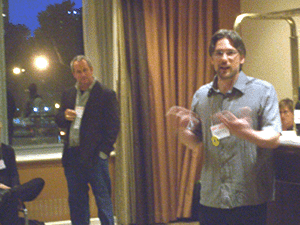Ants and Software Development: Thoughts from the ASA Conference
by MichaelF on August 16, 2006 06:12pm
I’ve been surrounded by people who want to study us like bugs—and they intend that as a compliment.
I just got back from the attending sessions of Communication and Information Technology Section of the American Sociological Association (CITASA) at the ASA conference in Montreal. This group of researchers studies:
The social aspects of computing, the Internet, new media, computer networks, and other communication and information technologies. This includes online communities, knowledge management, the digital divide, labor markets, workplaces, and how the Internet fits into everyday life [and] the design and use of technology [including] developing and analyzing new kinds of software, and thinking about the implementation of technologies for teaching, research, and the real world.

Myself and Prof. James Witte (Clemson), Chair of CITASA
The thought of bugs struck me when I sat down to recap my experience because, I thought—as a systems-minded person myself—an individual bug is not that interesting. But put a lot of bugs together, and the humble ant, bee, or termite, can, by acting in concert, create spectacular feats of engineering. Sound like building software? –That’s interesting.
What’s particularly important is that these practitioners focus on the criticality of social dynamics to any endeavor—the relevance to distributed, voluntary open source development is obvious, but these dynamics are important to closed-source development, diffusion and use of technology, information dissemination, bridging the “digital divide”…
I know I won’t do justice to everything here and now: suffice to say there are folks working on things like how building your reputation on Slashdot works (got your attention?); how to predict the level of documentation that will be produced by developers given different levels of social reinforcement for contributing code versus good documentation (…a challenge as applicable to proprietary as open source development, in my experience); and how different newsgroup communities use data to measure and control their “community health” (one group dedicated to quilting (yes, like with needles and fabric) seem to be particularly aggressive about this, going to show that traditional geek stereotypes may be becoming victims of the ubiquity of the Internet.) I’ll just promise that we will work hard on bringing some of the most interesting and relevant information, and interviewees, to Port25 over the next year.
Before I go nurse my jet lag, two quick notes:
First, since it is always nice to agree with the Boss (--which holds true for both Bill Hilf and Bruce Springsteen, IMHO), I will pile on Bill’s blog post about closed (or open) mindedness. If you happened to click through to CITASA’s website, you might have noticed something: our lab is a sponsor, Microsoft Research (MSR) is a participant (and a long-time participant and creator of some of the leading software for conducting social network analysis, I might add)—and the site is hosted by the Clemson Linux User Group. Bernie Hogan, one of the sociologists at the conference, said it best when the group turned to discussing “moral panic” (their words) or what one might also call hysteria (my word) about MySpace and “Internet Child Predators” right now: researchers have a critical role to play in “explaining what’s really happening.” I take as a point of pride that we share across our Port25 team, CITASA, MSR, and (I hope) you the reader a commitment to understand what’s really true—empirically measured, tested, challenged, tire-kicked…if everyone was focused on finding the demonstrably best solution to well-articulated scenarios, the world would be, IMHO, a better place…and the perceptions Bill referred to would take care of themselves expeditiously.
The second point is that my bug metaphor, above, has a basis in published research: Valverde, et al, from the University Pompeu Fabra, Barcelona, Spain, published “Self-organization patterns in wasp and open source communities” in IEEE Intelligent Systems, March-April 2006 (Volume 21, Issue 2). In this “comparative study of how social organization takes place in a wasp colony and OSS developer communities” they found “both systems also define interacting agent networks with similar common features that reflect limited information sharing among agents.”
And if you didn’t think that I really do care about tracking down every single bit of knowledge available to understand “what’s really going on”….I read the whole thing.